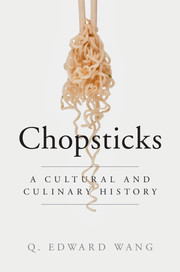Book contents
- Frontmatter
- Dedication
- Contents
- Acknowledgments
- List of Plates
- Timeline
- Map of East Asia
- 1 Introduction
- 2 Why chopsticks? Their origin and original function
- 3 Dish, rice or noodle? The changing use of chopsticks
- 4 Forming a chopsticks cultural sphere: Vietnam, Japan, Korea and beyond
- 5 Using chopsticks: customs, manners and etiquette
- 6 A pair inseparable: chopsticks as gift, metaphor and symbol
- 7 “Bridging” food cultures in the world
- Conclusion
- Glossary
- Bibliography
- Index
- Plate section
- References
1 - Introduction
Published online by Cambridge University Press: 05 February 2015
- Frontmatter
- Dedication
- Contents
- Acknowledgments
- List of Plates
- Timeline
- Map of East Asia
- 1 Introduction
- 2 Why chopsticks? Their origin and original function
- 3 Dish, rice or noodle? The changing use of chopsticks
- 4 Forming a chopsticks cultural sphere: Vietnam, Japan, Korea and beyond
- 5 Using chopsticks: customs, manners and etiquette
- 6 A pair inseparable: chopsticks as gift, metaphor and symbol
- 7 “Bridging” food cultures in the world
- Conclusion
- Glossary
- Bibliography
- Index
- Plate section
- References
Summary
Over one and a half billion people eat food with chopsticks daily. This is the first book in English that traces the history of the utensil from ancient times to the present day. The aim of this book is threefold. The first is to offer a comprehensive and reliable account of how and why chopsticks became adopted by their users and continued, as a dining habit, through the centuries in Asia and beyond. The second is to discuss the culinary impact of chopsticks use on Asian cookeries and cuisines and vice versa: how the change of foodways in the region influenced people’s choice of eating tools to aid their food consumption. And the third is to analyze the cultural meanings of chopsticks and chopsticks use in the respective cultures of their users. Chopsticks are distinctive in that though mainly an eating implement, they also have many other uses. A rich and deep cultural text is embedded in the history of chopsticks, awaiting our exploration.
Over many centuries, chopsticks have helped distinguish their users in Asia from those in the rest of the world. So much so that some Japanese scholars have identified a distinct “chopsticks cultural sphere” vis-à-vis the other two spheres on the globe: those who feed with fingers, which was a dining tradition for the people in the Middle East, South Asia and some parts of Southeast Asia, and those who eat with forks and knives, or the people who live in today’s Europe, North and South America, Australia, etc. Other scholars, such as Lynn White, have also noticed this tripartite division among the finger-feeders, the fork-feeders and the chopsticks-feeders in the world. Centering on China, where the utensil originated, the chopsticks cultural sphere encompasses the Korean Peninsula, the Japanese archipelago, certain regions of Southeast Asia, the Mongolian Steppe and the Tibetan Plateau. Thanks to the increasing global popularity of Asian foods in recent decades, this sphere is expanding – people outside the zone have increasingly adopted chopsticks while eating Asian foods. Indeed, in Chinese and other Asian restaurants throughout the world, many non-Asian customers attempt the use of chopsticks, with some showing admirable dexterity. In Thailand and Nepal, where the traditional dining method is to use one’s right hand, it is now increasingly common to see people use chopsticks to convey foods.
- Type
- Chapter
- Information
- ChopsticksA Cultural and Culinary History, pp. 1 - 15Publisher: Cambridge University PressPrint publication year: 2015



